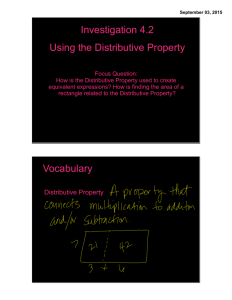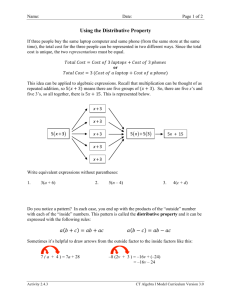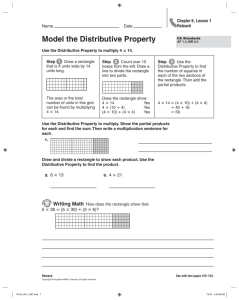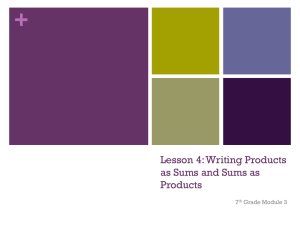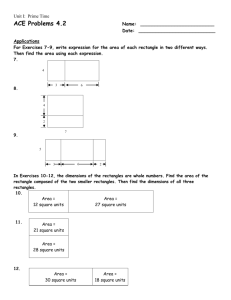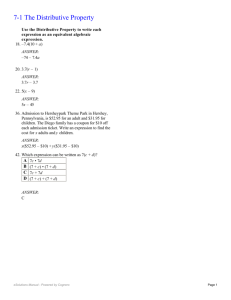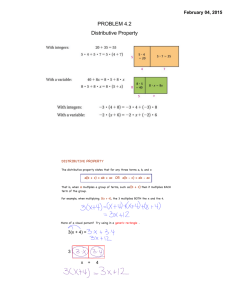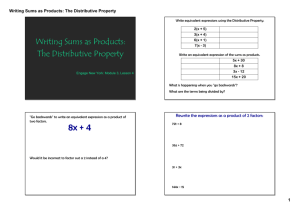Using Distributive Property
advertisement
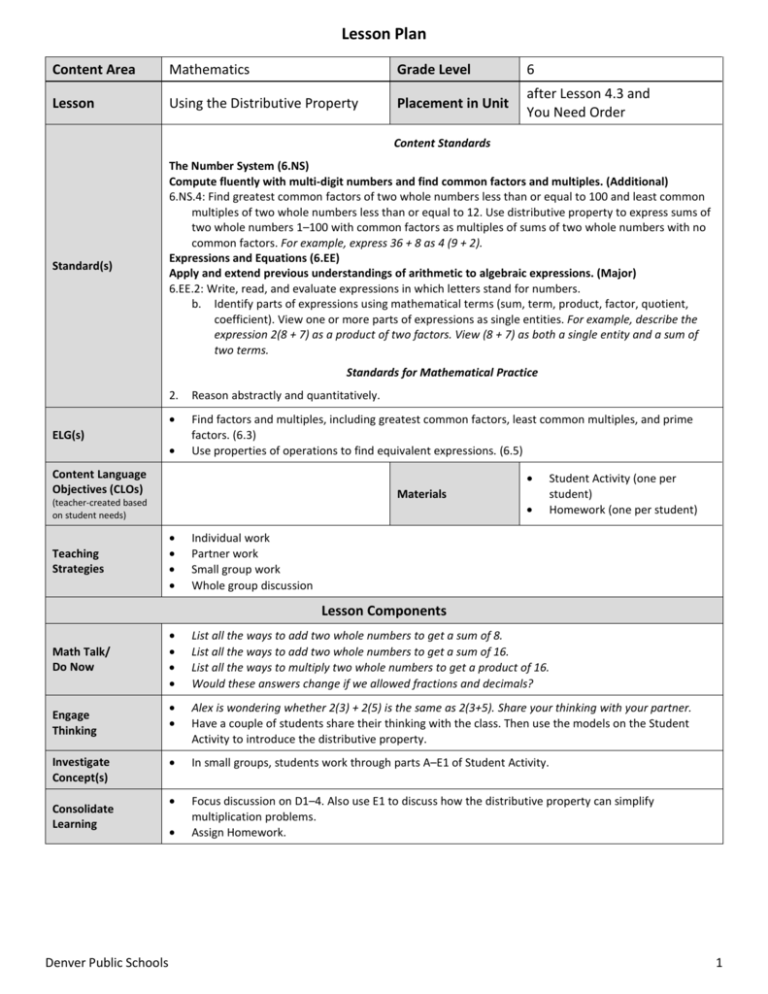
Lesson Plan Content Area Mathematics Grade Level 6 Lesson Using the Distributive Property Placement in Unit after Lesson 4.3 and You Need Order Content Standards Standard(s) The Number System (6.NS) Compute fluently with multi-digit numbers and find common factors and multiples. (Additional) 6.NS.4: Find greatest common factors of two whole numbers less than or equal to 100 and least common multiples of two whole numbers less than or equal to 12. Use distributive property to express sums of two whole numbers 1–100 with common factors as multiples of sums of two whole numbers with no common factors. For example, express 36 + 8 as 4 (9 + 2). Expressions and Equations (6.EE) Apply and extend previous understandings of arithmetic to algebraic expressions. (Major) 6.EE.2: Write, read, and evaluate expressions in which letters stand for numbers. b. Identify parts of expressions using mathematical terms (sum, term, product, factor, quotient, coefficient). View one or more parts of expressions as single entities. For example, describe the expression 2(8 + 7) as a product of two factors. View (8 + 7) as both a single entity and a sum of two terms. Standards for Mathematical Practice ELG(s) 2. Reason abstractly and quantitatively. • Find factors and multiples, including greatest common factors, least common multiples, and prime factors. (6.3) Use properties of operations to find equivalent expressions. (6.5) • Content Language Objectives (CLOs) Materials (teacher-created based on student needs) Teaching Strategies • • • • • • Student Activity (one per student) Homework (one per student) Individual work Partner work Small group work Whole group discussion Lesson Components Math Talk/ Do Now Engage Thinking Investigate Concept(s) Consolidate Learning Denver Public Schools • • • • List all the ways to add two whole numbers to get a sum of 8. List all the ways to add two whole numbers to get a sum of 16. List all the ways to multiply two whole numbers to get a product of 16. Would these answers change if we allowed fractions and decimals? • • Alex is wondering whether 2(3) + 2(5) is the same as 2(3+5). Share your thinking with your partner. Have a couple of students share their thinking with the class. Then use the models on the Student Activity to introduce the distributive property. • In small groups, students work through parts A–E1 of Student Activity. • Focus discussion on D1–4. Also use E1 to discuss how the distributive property can simplify multiplication problems. Assign Homework. • 1 Student Activity Name: Lesson Period: Using the Distributive Property Tori made a conjecture that the sum of two even numbers is an even number. She used square tiles to show why the sum of two even numbers is always even. John wondered if this means that 2(3) + 2(5) = 2(3+5). What do you think? Are Tori and John correct? Explain why or why not. Tori’s picture represents an important property of numbers called the distributive property. The distributive property connects the operations of addition and multiplication. You can write the number 16 as the sum of two quantities, 6 and 10. You can write the number 16 as the sum of two other quantities, 2(3) and 2(5). You can write the number 15 as a product of two factors, 2 and 8. You can also write 16 as the product of two other factors, 2 and (3 + 5). The expressions 2(3) + 2(5) and 2 (3 + 5) are equivalent expressions. Tori thinks that the distributive property explains how the area of a rectangle can be found in two different ways. Is she correct? Explain. Denver Public Schools 2 Student Activity Name: Lesson Period: Using the Distributive Property PART A In each diagram below, a large rectangle has been made from two smaller rectangles. In each case, show two different ways to calculate the area of the large rectangle. 1. 2. 3. 4. PART B A large rectangle has an area of 28 square units. It has been divided into two smaller rectangles. One of the smaller rectangles has an area of 45 square units. What are possible whole-number dimensions of the large rectangle? Justify your reasoning. Denver Public Schools 3 Student Activity Name: Lesson Period: Using the Distributive Property PART C Each of the following numerical expressions represents the area of a rectangle that has been divided into two smaller rectangular pieces. For each expression, • Sketch a rectangle whose area can be represented by the expression. • Write an equivalent expression for the area of the original rectangle. 1. 2. 6(5 + 9) 4(7) + 4(3) PART D Mrs. Johnson’s and Mr. Wei’s classes are participating in the Meridian School arts and crafts exhibit. Their spaces will be next to each other. Mrs. Johnson’s space will be longer, but it will have the same width as Mr. Wei’s space. Mrs. Johnson has 48 carpet squares. Mr. Wei has 36 carpet squares. 1. 2. 3. 4. Use the distributive property to find the possible whole number dimension of the classes’ total exhibition space. Explain what each number means in your expressions. What is the greatest width that their exhibition space can have? What is the corresponding depth/length? Which expression represents these dimensions? What is the length of each class’s space if you use the greatest width? Do these lengths have any common factors? Explain. Mr. Casey writes the equation 40 = 16 + 24 = a(b + c). What whole numbers can he choose for a, b, and c if he wants b and c to have no common factors greater than 1? PART E You can use the area of a rectangle, the distributive property, and what you know about place value to find products. Explain how you can use the diagram to find the product 8 x 27. How does this process represent the distributive property? Denver Public Schools 4 Homework Name: Lesson Period: Using the Distributive Property For Exercises 1–3, write expressions for the area of each rectangle in two different ways. Then find the area using each expression. 1. First expression: Area: Second expression: Area: 2. First expression: Area: Second expression: Area: 3. First expression: Area: Second expression: Area: Denver Public Schools 5 Homework Name: Lesson Period: Using the Distributive Property For Exercises 4–6, the dimensions of the rectangles are whole numbers. Find the area of the rectangle composed of the two smaller rectangles. Then find the dimensions of all three rectangles. Label the dimensions on the diagram. 4. Area of rectangle composed of the two smaller rectangles: 5. Area of rectangle composed of the two smaller rectangles: 6. Area of rectangle composed of the two smaller rectangles: Denver Public Schools 6 Homework Name: Lesson Period: Using the Distributive Property For Exercises 7–9, draw a rectangle with the given width and length. Then use the distributive property to write each area as a product and as a sum. 7. 3 and (4 + 6) 8. 3 and (5 + 1 + 3) 9. N and (2 + 6) For Exercises 10–11, the task is to first find all of the common factors for each of the expressions. For each common factor, write a number sentence. Choose one common factor for each number sentence and draw a model. Decide which number sentence would help you do mental computation more easily and more accurately. 10. 45 + 18 11. 64 + 32 Denver Public Schools 7
